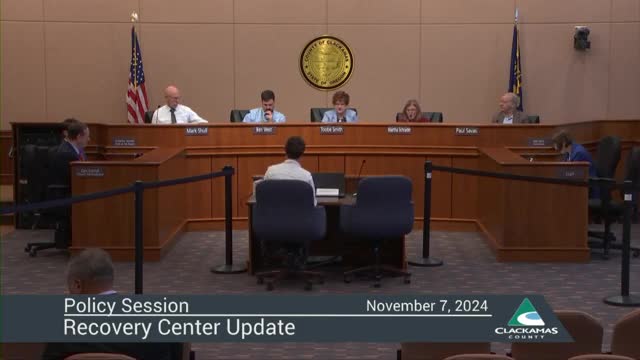Clackamas County discusses National Flood Insurance compliance amid FEMA challenges
This article was created by AI summarizing key points discussed. AI makes mistakes, so for full details and context, please refer to the video of the full meeting. Please report any errors so we can fix them. Report an error »

In the heart of Clackamas County, a pivotal discussion unfolded during the recent policy session, focusing on the National Flood Insurance Program (NFIP) and its implications for local residents. As the meeting commenced, Dan Johnson, the Director of Transportation and Development, alongside Planning Director Jennifer Hughes, laid the groundwork for a complex yet crucial topic that affects thousands of lives in the region.
The backdrop of this discussion was the expansive 15,000 acres of special flood hazard areas scattered throughout Clackamas County. These zones, which encompass urban, rural, and wild landscapes, are not just geographical markers; they represent the homes and businesses of residents who rely on federally backed flood insurance to protect their properties. Johnson emphasized the importance of the NFIP, managed by the Federal Emergency Management Agency (FEMA), which provides essential coverage to homeowners, renters, and businesses within these flood-prone areas.
However, the meeting took a serious turn as Johnson outlined the potential consequences of withdrawing from the NFIP. Currently, approximately 980 policies exist in Clackamas County, covering improvements valued at around $290 million. If the county were to exit the program, residents would lose access to these federal flood insurance policies, leaving them vulnerable to financial ruin in the event of flooding. Furthermore, the withdrawal would eliminate federal grants and loans for development, as well as disaster assistance for repairs, significantly impacting the community's resilience against natural disasters.
Jennifer Hughes then took the floor to explain the broader context of the NFIP's challenges. She detailed a legal battle that began in 2009, when FEMA was sued by environmental organizations over the program's compliance with the Endangered Species Act. This lawsuit led to a settlement requiring FEMA to consult with the National Marine Fisheries Service, which ultimately identified risks to various fish species and the southern resident killer whales. The resulting recommendations could reshape the NFIP's regulations, affecting not only Clackamas County but also 30 other counties and numerous cities across Oregon.
As the meeting progressed, the urgency of the situation became clear. With FEMA's implementation plan expected to roll out by 2027, local officials are faced with critical decisions that will shape the future of flood management and insurance in the county. The discussions highlighted the delicate balance between environmental protection and community safety, underscoring the need for informed decision-making in the face of impending regulatory changes.
As the session concluded, the implications of the NFIP's future loomed large over Clackamas County. Residents and officials alike are left to ponder the potential impacts on their homes, livelihoods, and the environment, as they navigate the complexities of flood insurance and compliance measures in the years to come.
The backdrop of this discussion was the expansive 15,000 acres of special flood hazard areas scattered throughout Clackamas County. These zones, which encompass urban, rural, and wild landscapes, are not just geographical markers; they represent the homes and businesses of residents who rely on federally backed flood insurance to protect their properties. Johnson emphasized the importance of the NFIP, managed by the Federal Emergency Management Agency (FEMA), which provides essential coverage to homeowners, renters, and businesses within these flood-prone areas.
However, the meeting took a serious turn as Johnson outlined the potential consequences of withdrawing from the NFIP. Currently, approximately 980 policies exist in Clackamas County, covering improvements valued at around $290 million. If the county were to exit the program, residents would lose access to these federal flood insurance policies, leaving them vulnerable to financial ruin in the event of flooding. Furthermore, the withdrawal would eliminate federal grants and loans for development, as well as disaster assistance for repairs, significantly impacting the community's resilience against natural disasters.
Jennifer Hughes then took the floor to explain the broader context of the NFIP's challenges. She detailed a legal battle that began in 2009, when FEMA was sued by environmental organizations over the program's compliance with the Endangered Species Act. This lawsuit led to a settlement requiring FEMA to consult with the National Marine Fisheries Service, which ultimately identified risks to various fish species and the southern resident killer whales. The resulting recommendations could reshape the NFIP's regulations, affecting not only Clackamas County but also 30 other counties and numerous cities across Oregon.
As the meeting progressed, the urgency of the situation became clear. With FEMA's implementation plan expected to roll out by 2027, local officials are faced with critical decisions that will shape the future of flood management and insurance in the county. The discussions highlighted the delicate balance between environmental protection and community safety, underscoring the need for informed decision-making in the face of impending regulatory changes.
As the session concluded, the implications of the NFIP's future loomed large over Clackamas County. Residents and officials alike are left to ponder the potential impacts on their homes, livelihoods, and the environment, as they navigate the complexities of flood insurance and compliance measures in the years to come.
View full meeting
This article is based on a recent meeting—watch the full video and explore the complete transcript for deeper insights into the discussion.
View full meeting